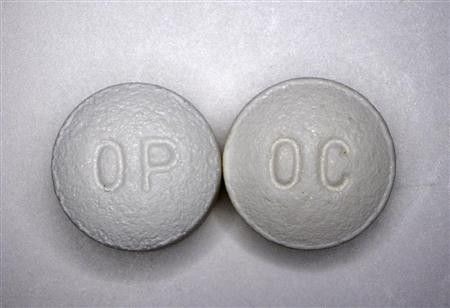[EMBARGO 5PM] Many OxyContin Addicts Switching To Heroin After Formula Change: Study

[EMBARGO 5PM]
OxyContin addicts are finding it harder to abuse their prescription drug of choice thanks to changes to the painkiller's formula, and many are now switching to other drugs like heroin instead, according to new research published in the New England Journal of Medicine.
Purdue Pharma, the maker of OxyContin, altered the drug's composition back in 2010 in such a way that the pill is harder to crush and, when dropped in water, it turns into a gel instead of dissolving. People can still abuse the drug by swallowing it, but it's more difficult for them to snort or inject it, which many addicts do to obtain a quick fix.
But just removing an addict's access to one kind of high doesn't necessarily solve the problem, according to Washington University School of Medicine in St. Louis researcher Theodore J. Cicero, first author of the NEJM letter.
Substance abuse is like a big balloon. Press in one spot and it's going to pop up somewhere else, Cicero said in a phone interview.
Cicero and his colleagues surveyed more than 2,500 painkiller addicts about their drug habits and found that OxyContin's status as the primary drug of choice among opiate users decreased from 35.6% of respondents before the introduction of the new formula to 12.8% nearly two years later. But at the same time, other drugs became the substance of choice.
In more in-depth interviews with a subgroup of 103 patients, 66% said they had switched to another opoid drug. Heroin was the most commonly preferred alternative, meaning users are entering a much riskier arena of drug abuse, Cicero says.
Unlike OxyContin, which is manufactured under controlled conditions and which has a carefully measured dosage, heroin users can never be quite sure of the purity of their drugs, or what additional substances have been added to cut the mixture.
What you're going to see is a lot of heroin overdoses, Cicero warns.
Kristin Helm, a spokesperson for the Tennessee Bureau of Investigation, says her department's seen a small uptick in heroin use in their state, but officials there think it's more a matter of economics: whereas a single OxyContin pill on the black market can go from anywhere from $20 to $80 a pill, a dose of heroin costs only about $5.
In addition to overdoses, heroin carries other dangers: increased risks for hepatitis C and HIV from users sharing dirty needles, for example.
Cicero thinks that actions like Purdue Pharma's can't be the be-all and end-all of drug policy. He thinks more funding is needed for preventative measures - such as vaccines, like ones being currently developed for cocaine and nicotine addiction.
I'm not saying we should give up on efforts to regulate the drug supply, but we've got to find some way to reduce desire for drugs, Cicero says.
Purdue Pharma says the trend found by Cicero and his colleagues is consistent with studies conducted by the company, and suggests that to curb painkiller abuse, other companies should follow its example.
It is unreasonable to expect the reformulation of one medication by one pharmaceutical company would reduce overall opioid abuse, the company said in a statement.
SOURCE: Cicero et al. Effect of Abuse-Deterrent Formulation of OxyContin. New Eng J Med 187-189, 12 July 2012.
© Copyright IBTimes 2024. All rights reserved.





















